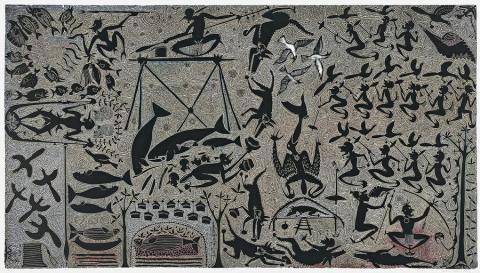SESSERAE (BADU ISLAND STORY), 2004 - 05
DENNIS NONA
hand coloured linocut
112.0 x 200.0 cm
Aboriginal Art Print Network, Sydney
Private collection, Sydney
Seear, L., and Ewington, J., (eds.) Brought to Light II, Contemporary Australian Art 1966 – 2006 from the Queensland Art Gallery Collection, p. 326 – 27 (illus.)
Wright, S.P. (ed.), Sesserae – the works of Dennis Nona, Griffith Artworks, Brisbane, 2005, cover (illus.), p. 52 and p. 54
McCulloch, S., and McCulloch Childs, E., McCulloch's Contemporary Aboriginal Art: the complete guide, McCulloch & McCulloch Australian Art Books, 2008, p. 275 (illus.)
Other examples of this edition are in the collections of the National Gallery of Australia, Canberra, Museum of Contemporary Art, Sydney, British Museum, London, and the Musée de Confluences, Lyon, France
Dennis Nona was born on Badu Island, in the Western Torres Strait, Queensland. As a child, Nona learned his cultural heritage through story-telling, dance and ceremonies. Inspired by the Islanders traditional mythology, he reinterprets this heritage in print and sculptures.
After being awarded the Fourth International Angel Orensanz Foundation Art Award in New York in 2004, Nona received almost instant international recognition. His first solo exhibition, Sesserae, was held at Dell Gallery, Queensland College of Art in 2005. He was the youngest recipient of the National Aboriginal and Torres Strait Islander Art Award and his work was included in Culture Warriors: National Indigenous Art Triennial which was held at the National Gallery of Australia, Canberra in 2007.
Sesserae (Badu Island Story), 2004-2005, is his largest work, and took Nona six months to carve using a single blade.
Dr Nonie Sharp, details the myth underpinning this work as one where '...a young man named Sessere is given the knowledge to catch dugong by his dead parents in a dream. Based on the knowledge given to him in his dream, Sessere erects the first platform from which he harpoons the dugong. The story concludes with Sessere transforming himself into a willie wagtail to hide from his enemies, who want to kill him for the prized dugong meat hanging from the roof of his house. No man is strong enough to kill the spiritually powerful willie wagtail and soon all his enemies are dead. Sessere, the innovator of dugong hunting techniques and tools, is the founder of the Islanders' prowess and skill in dugong hunting.'1
1 Sharp, N., 'New Waves from the Old: Torres Strait Islander Printmaking' in Seear, L., and Ewington ,J., (eds.) Brought to Light II, Contemporary Australian Art 1966 - 2006 from the Queensland Art Gallery Collection, p. 329
